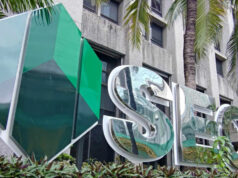Trade gap grows as exports drop
MERCHANDISE EXPORTS in February fell for the first time in 15 months while imports continued to grow by double digits leading to a wider trade deficit, the Philippine Statistics Authority (PSA) reported yesterday.

Preliminary data from the PSA showed merchandise export sales dropped 1.8% to $4.659 billion, compared to the revised 3.5% growth in January and 8.7% increase in February 2017.
The last time exports posted a decline was in November 2016 when they logged a 4.5% reduction.
With total imports recording an 18.6% expansion to $7.725 billion last February, the country’s balance of trade in goods deficit widened by 73.4% to $3.065 billion year on year.
The latest merchandise export turnout brought year-to-date sales to $10.032 billion, up a percent from the $9.934 billion in the same two months of last year.
The year-to-date export growth compares to the Development Budget Coordination Committee’s projection of nine percent for the entire 2018. On the other hand, the 14.7% cumulative growth in imports had already surpassed the official 10% target this year.
Outbound shipments for manufactured goods, which accounted for 84.4% of total exports in February, went down 1.1% to $3.934 billion from $3.978 billion in February 2017.
Bucking the overall drop among manufactured exports were electronic products, which managed to grow 4.6% to $2.583 billion.
Likewise, agro-based products — with a 4.7% share of the total — decreased by 31% to $219.266 million while petroleum products dropped 50.6% to $13.934 million.
The United States was the Philippines’ top export market in February with a 15.1% share at $705.2 million, followed by Japan’s 14.6% ($680.76 million) and Hong Kong’s 13.7% ($636.04 million) market shares.
On the import side, capital goods — which accounted for 33.4% of total import payments in February — increased by 24.5% to $2.583 billion.
Raw materials and intermediate goods — which had a 38% share — also grew by 19.2% to $2.934 billion.
Consumer goods as well as mineral fuels, lubricants and related materials recorded increases of 20.3% (to $1.353 billion) and a flat 0.1% (to $828.177 million), respectively.
China was the country’s top source of imports with a 19.9% share in February ($1.541 billion) followed by Japan’s 10.4% ($804.61 million) and Korea’s 9.9% ($765.66 million) shares.
“The slump of the export sector was a bit of a surprise since manufacturing production was robust during that month and there was a peso depreciation that ought to make export items more competitive,” said Angelo B. Taningco, economist at Security Bank Corp.
“I think the export contraction may have been due to tepid external demand for Philippine manufactured and petroleum products as well as adverse weather conditions that may have limited the export supply of agro-based products.”
For imports, the economist noted that this was expected given the government’s aggressive infrastructure spending coupled with a “vibrant” household spending and capital formation.
In a statement, National Economic and Development Authority (NEDA) quoted Officer-in-Charge and Undersecretary for Policy and Planning Rosemarie G. Edillon as citing lower receipts from foreign sales of agro-based products due to the “lingering effects of tropical storms that hit Visayas and Mindanao during the latter part of 2017 as well as the substitution of coconut oil with more competitively priced palm oil in some markets.”
Nevertheless, NEDA remained optimistic on the country’s trade prospects. “It is essential for the national government to continuously support Philippine trade, especially exports, by providing an enabling environment to become globally competitive,” Ms. Edillon said.
Jose Mario I. Cuyegkeng, senior economist at ING Bank, described the February trade data as “double edged” as more imports of capital goods and raw materials signaled strong domestic demand, although the widening trade gap spelled continued weakness for the Philippine peso.
“Capital equipment imports have largely been on a tear since early 2015 and have contributed to the strong overall economic expansion of 6.6% in the past three years,” Mr. Cuyegkeng said.
On the other hand, the peso has lost 17% since the end of 2014 while exports posted an average annual growth of a “barely” 1%, the economist noted.
For Mr. Cuyegkeng, the widening trade deficit is expected to continue with exports not being able to benefit from the depreciating peso.
“Fears of [the US-China] trade war and likely less competitiveness of Philippine exports compounded by a limited range of exports would likely keep export growth anemic. And such a combination of strong imports and weak exports would likely see wider trade deficits,” Mr. Cuyegkeng added.
For Security Bank’s Mr. Taningco, exports may have rebounded in March and the ensuing trade-war between the US and China “would not have a significant effect.”
“The current pace of US-China trade dispute is unlikely to have a substantial impact on Philippine merchandise trade in the near term because the tariffs that have been enforced so far by the two countries are relatively small,” Mr. Taningco said.
“However, if the US-China trade dispute prolongs and escalates in terms of additional trade retaliations, i.e., more tariffs and investment restrictions imposed by the two countries, then this would likely have an adverse impact on Philippine trade and economic growth over the medium term.”
Sergio R. Ortiz-Luis, Jr., president of the Philippine Exporters Confederation, Inc., hopes export performance will recover this quarter, as he shared the economists’ views that the US-China row will not impact the Philippine trade by that much.
“I’m not worried because China and the US are both looking at us in a good way,” he said.
The US and China have been exchanging higher tariffs on each other’s imports as US President Donald J. Trump tries to pressure Beijing to honor intellectual property rights. Mr. Trump last month imposed higher taxes on steel and aluminum imports, to which China responded with a $3 billion worth of tariffs on US fruits, nuts, pork, and wine. — Denise A. Valdez



